Stories
City Shorts
1987-1990
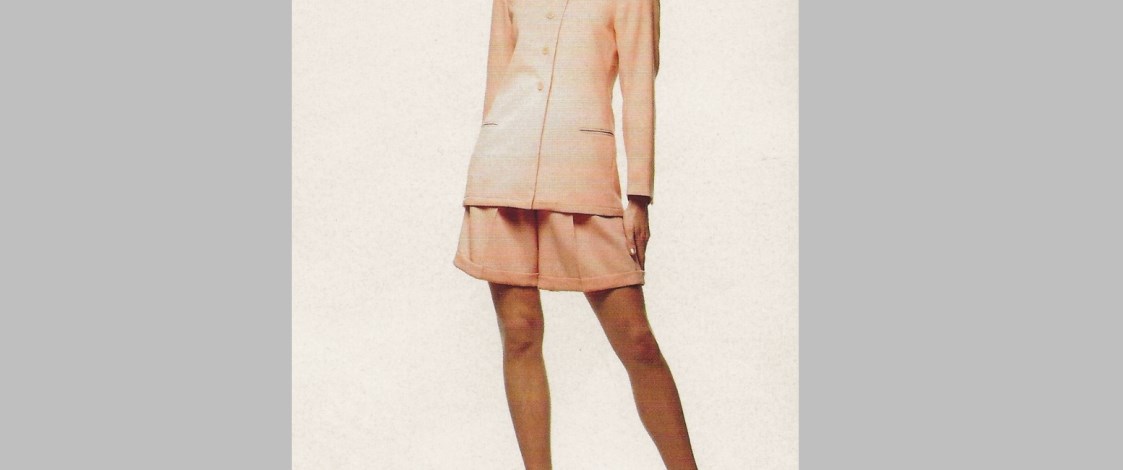
In Paris they called them Les pantalons de L’Été (the pants of summer) pour la cité (for the city). In New Zealand they were known as city shorts. Worn with a jacket in the form of a suit, the shorts were power-dressing’s corporate alternative to the miniskirt which resurfaced on the international fashion scene in 1987.
Auckland label Street Life was one of the first off the block with a wool tweed cropped jacket and high-waisted city shorts in their 1988 winter collection but it wasn’t until summer of that year that they hit their stride here.
For hemline watchers the message was mixed. Unlike the 1960s, skirts came in various lengths and styles. The straight, snug-fitting mini was just one option, an option suitable for multiple occasions but not the boardroom. While professional women liked the broad-shouldered jacket and the authority it conferred, they weren’t keen on turning up for business meetings in a skirt that would have male associates looking at their legs, rather than listening to what they had to say. The shorts suit, habitually cut to a few centimetres above the knee or a little higher, had the advantage of being up with the fashion play, regarding shorter lengths, without being a distraction. It was customarily worn with pantyhose a shade paler than skin tone.
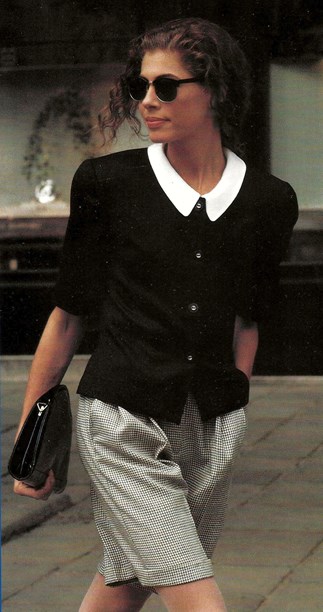
Keith Matheson cuffed cool wool shorts, black jacket and white silk blouse. Fashion Quarterly, Spring 1988.
Co-ordinated with a matching jacket, and often cuffed, city shorts also tapped into the trend for androgyny, loosely appropriating masculine style. Slipping the jacket over a lace t-shirt, a silk singlet, a crisp shirt or an embroidered blouse rendered the look more feminine.
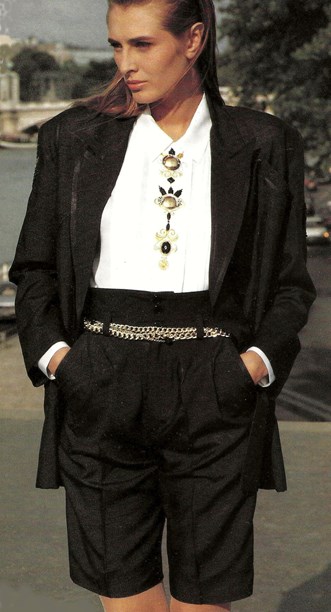
Teamed with a white blouse featuring an embroidered front panel, an Adele Palmer black silk shorts suit made by the Hall Corporation, the Australian label’s New Zealand licensee. Fashion Quarterly, Spring 1988.
Short or long-sleeved, collared or collarless, jackets balanced the line of the shorts. Some were cropped, others elongated and double-breasted, permitting only the lower half of the shorts to show. Unstructured jackets, similar to those created by Giorgio Armani for his Emporio Armani collection, were usually worn unbuttoned.
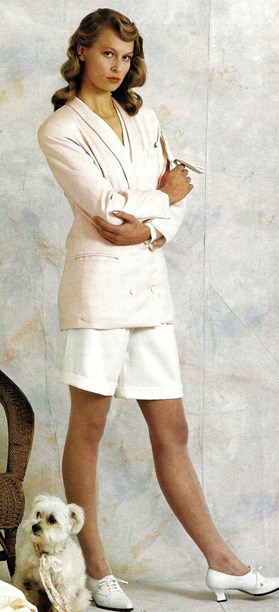
A Keith Matheson double-breasted long-line jacket in pale pink complements a pair of white cuffed shorts in cool wool. Fashion Quarterly, Spring 1988. Photo by Ken Middleton.
Keeping accessories simple helped maintain a business-like image. Footwear ran mainly to low-heeled, two tone spectator shoes - lace-ups and semi-brogues - with oval-shaped toes and occasionally fancy punchwork. Local shoemakers Marler, Andrea Biani and David Elman all warmed to the theme, producing several style variations. Bags were similarly low key – satchels and capacious clutches big enough to hold a Filofax - nothing fancy.
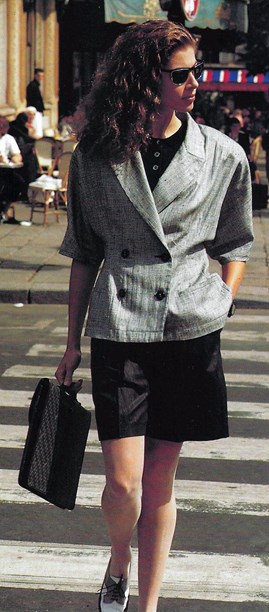
Black city shorts and contrasting jacket by Daniel Hechter, a French label made under license in New Zealand by Ninon Modes, Wellington. Fashion Quarterly, Spring 1988.
Jewellery, if it was worn at all, was a gesture rather than a statement - disc or geometric earrings in black, white, silver or gold, a mannish watch perhaps or a wide bangle.

Thornton Hall double-breasted shorts suit in neutral linen with button detail and jetted pockets. More Fashion, Spring/Summer 1988.
Some saw the re-emergence of the mini in 1987 as a manifestation of anti-feminist backlash. It was a contentious issue, particularly in the US where it was subject to surveys, protests and TV and radio debates. One of eight New Zealand designers asked by Fashion Quarterly how they viewed the mini, Barbara Lee gave it the thumbs up. "We shouldn’t be hobbled in the '80s. I think short skirts look wonderful on anyone who’s got a good pair of legs." In her 1988 spring/summer collection Barbara showed both mini-skirts and city shorts. Paired with well-cut jackets, her shorts featured high waists and were sassy and chic as befitted her signature style.
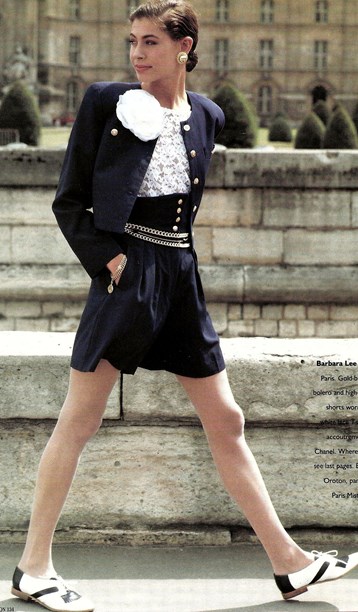
Barbara Lee high-waisted shorts, matching jacket and white lace t-shirt photographed in Paris for Fashion Quarterly, Spring 1988. Two-tone spectator shoes by Marler.
While acknowledging in the same FQ article that the new short skirt length was "inevitable" and that she would get used to it, Rosaria Hall expressed her preference for less leg, more skirt. The shorts she designed for her 1988 summer collection reflected this preference. Voluminous and reaching almost to the knee, at first glance they could easily be mistaken for a skirt.
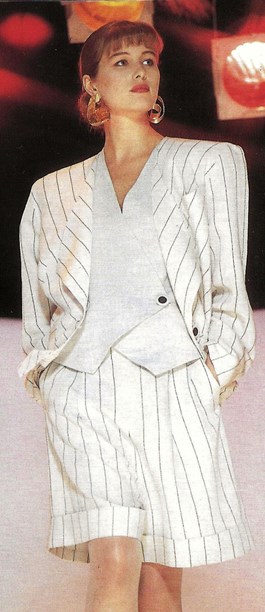
Three easy pieces by Rosaria Hall – a jacket and shorts in pencil-striped linen and an asymmetric waistcoat-hem top. Summer 1988.
As well as cut, colour and fabric dictated the mood. Black and navy dominated one end of the colour spectrum, neutrals, white and baby pinks and blues, the other. Plain-coloured fabrics were the most popular with a nominal use of prints. These ranged from plaids and checks of varying sizes to bold houndstooth patterns and subtle stripes.
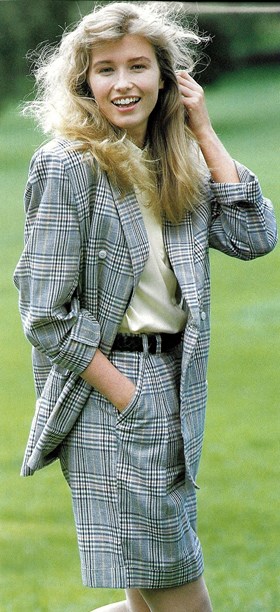
Plaid co-ordinates by French Connection from The House of Janak. Spring/Summer 1988.
Explaining her choice of pales for her '88 shorts suits, designer Jane Daniels says that for her, it has always been either wow styling or wow colour, not both in the same garment. "If the style is a statement, the garment needs to be in a neutral colour in order to be commercially successful." Memories of that long-ago summer have prompted Jane to contemplate doing a city shorts suit in charcoal with a white t-shirt in her next summer collection.
The city shorts concept captured the imagination of the fashion industry in general, not just individual designers. In More Fashion magazine, Russell Jones of Macjays Clothing hailed the city shorts/jacket combo as "the suit of the season", a view shared by many of his fellow apparel manufacturers, all of whom featured the look in their summer ranges. The list, which included Macjays (Closed label), Vamp, Peppertree, Sherwood, Underground Fashions, Charade, Thornton Hall, French Connection (House of Janak), Max Fashions, Daniel Hechter, Adele Palmer and Jag (the latter three labels made under license in New Zealand) read like a rag trade Who’s Who.
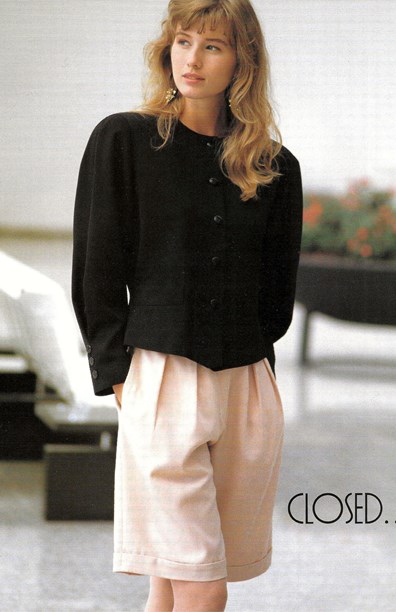
Pleating, power shoulders and a contrasting jacket define a Closed label shorts suit by Macjays Clothing. Spring/Summer 1988.
Unlike knickerbockers (1982), which lasted one season, city shorts had a longer run, continuing to crop up until well into 1990. Since then, they have made periodic comebacks, the most recent being in the UK in 2019. Singling out the sorbet-coloured city shorts and boxy blazer worn by Julia Roberts in the 1990 movie Pretty Woman, British Vogue cited the look as 'totally on-trend for Spring/Summer19'.
Text by Cecilie Geary. Banner image of Keith Matheson city shorts suit, Summer 1988. Image © More Fashion.
Published February 2020.